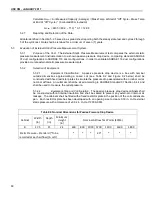
USE OM - JANUARY 2017
49
3.1
Air-Source Unitary Heat Pump.
One or more factory-made assemblies which normally include: indoor conditioning
coil(s), compressor(s), and outdoor coil(s), including means to provide a heating function. When such equipment is provided
in more than one assembly, the separated assemblies shall be designed to be used together, and the requirements of
rating outlined in the standard are based upon the use of matched assemblies.
3.1.1
Functions
. They shall provide the function of air heating with controlled temperature, and may include
the functions of air-cooling, air-circulating, air-cleaning, dehumidifying or humidifying.
3.2
Code Tester.
A chamber with one or more nozzles, diffusion baffles and mixing plates used to measure air flow
rate (reference ASHRAE Standard 37 Section 6); sometimes referred to as a wind tunnel.
3.3
Degradation Coefficient (C
D
).
The measure of the efficiency loss due to the cycling of the units as determined in
the latest edition of Appendices C and D of AHRI Standard 210/240.
3.4
Design Heating Requirement (DHR).
This is the amount of heating required to maintain a given indoor temperature
at a particular outdoor design temperature.
3.5
Energy Efficiency Ratio (EER).
A ratio of the cooling capacity in Btu/h to the power input value in watts at any given
set of Rating Conditions expressed in Btu/(W·h).
3.6
Heating Seasonal Performance Factor (HSPF).
The total space heating required during the space heating season,
expressed in Btu’s, divided by the total electrical energy consumed by the heat pump system during the same season,
expressed in watt-hours.
3.7
Laboratory Certification Tests.
Any test used in the determination of capacity and efficiency of an Unitary Air-
Conditioner or Unitary Heat Pump; these tests are listed in AHRI Standard 210/240 Section 6.1.4. This includes tests during
development of performance ratings or tests during auditing of performance ratings.
3.8
Laboratory Facility.
Any organization that has psychrometric test rooms, data acquisition, and other equipment
necessary to determine the performance of an Unitary Air-Conditioner or Unitary Heat Pump, with the intent of using the
facility for Laboratory Certification Tests or qualifying new product under the penalty mode in the latest edition of AHRI USE
Operations Manual. An AHRI member, a non-AHRI member, or any other independent organization may be a Laboratory
Facility.
3.8.1
Authorized Laboratory Facility.
A Laboratory Facility that has completed all tests in compliance with
this appendix and has been provided with a letter of approval from AHRI for use of their facility for AHRI certification
testing.
3.8.2
OEM Laboratory Facility
. A laboratory facility utilized by an Original Equipment Manufacturer to
develop certified ratings.
3.9
Laboratory Evaluation & Adjustment Plan (LEAP).
A program to evaluate Laboratory Facilities use in performance
testing of the AHRI USE Certification Program; the program provides the Laboratory with directions to adjust testing process
and results in order to conform to the requirements of AHRI USE Operations Manual.
3.10
Psychrometric Test Facility.
A pair of test chambers used to separately simulate indoor and outdoor ambient
conditions, in which each chamber has the capability of separately controlling dry-bulb temperature and wet-bulb
temperature within the chamber, and measuring various parameters of a unit under test.
3.10.1
Indoor Room.
A test chamber specifically intended for installation of an indoor section of a Unitary Air-
Conditioner or Unitary Heat Pump, and designed to control ambient air in the range as specified in
AHRI Standard 210/240 Section 6.1.4 indoor conditions.
3.10.2
Outdoor Room.
A test chamber specifically intended for installation of an outdoor section, or complete
single package unit, of a Unitary Air-Conditioner or Unitary Heat Pump, and designed to control ambient air in the
range as specified in AHRI Standard 210/240 Section 6.1.4 indoor conditions.
















































